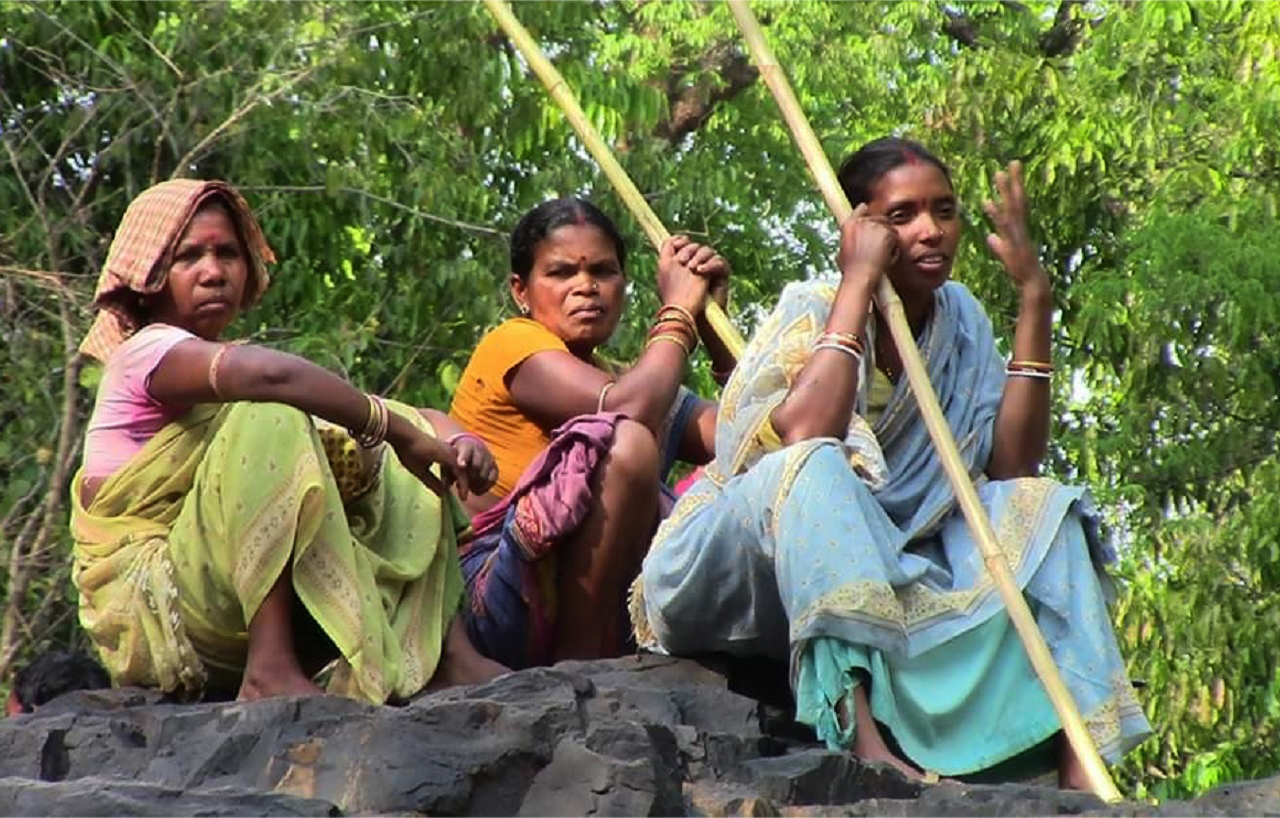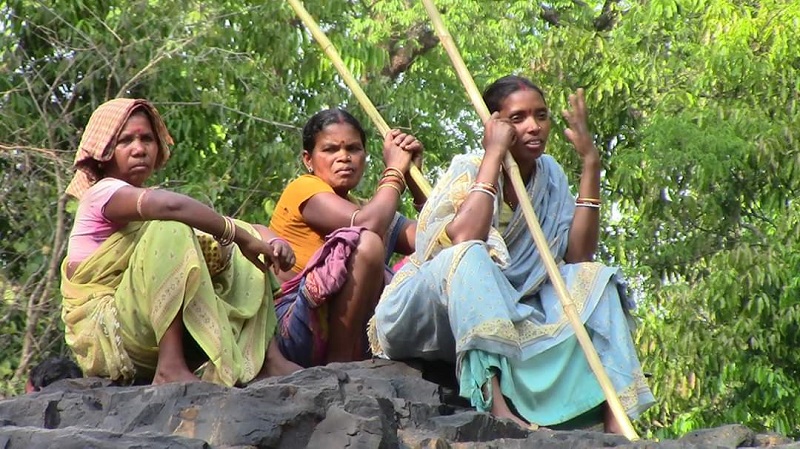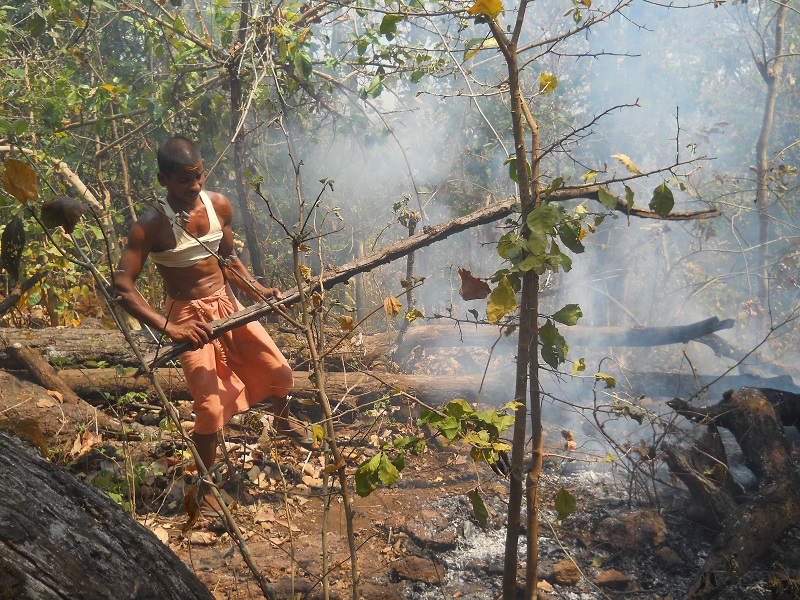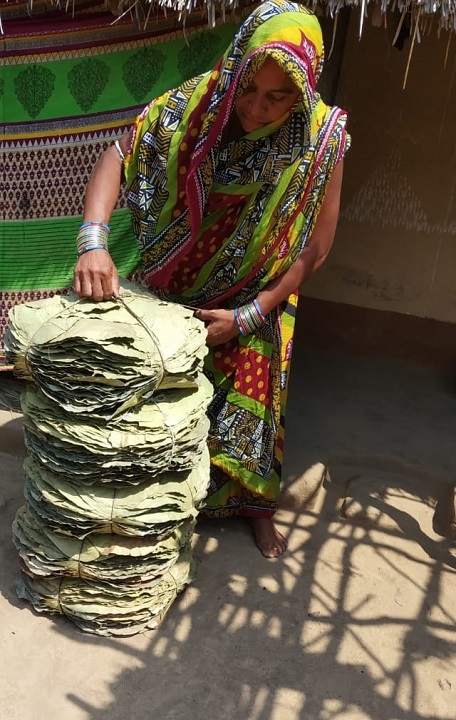A Press Note on the COVID 19 and Climate Crisis – A Double whammy for Adivasi & Forest Dwelling Communities in India and #IAmAClimate Warrior CAMPAIGN. #IAmAClimateWarrior Campaign was a Collective Initiative of the CSO’s and People’s Forum, with a vision to showcase the contribution of Adivasi & Forest Dwelling Communities in Climate Justice by presenting Testimonies of the community members illustrating their Community Led Forest Protection and Ecosystem Restoration through their Traditional Knowledge and Practices and way of Living .
The World Environment Day on 5th June 2020 came at a time when India is severely hit by the COVID 19 crisis with a large population of poor and vulnerable communities getting affected by the outbreak and the unplanned lockdown measures. The Adivasi and forest dwelling communities are among the worst affected due to the spread of disease into tribal areas and a crippling impact of the lockdown on their forest based economy as well as timely implementation of the Scheduled Tribes and Other Traditional Forest Dwellers (Recognition of Forest Rights) Act, 2006 (FRA).[1] The COVID response by the Central government has brought in a series of measures by the environment ministry which seek to ease the statutory forest and environmental clearance for mining and extractive projects, thereby indulging in ecocide while we stand at the brink of a Climate Crisis.
Why Adivasi and forest dwelling communities matter for addressing the Climate Crisis?
The 2019 IPCC Report on Land had stressed the importance of well-defined land tenure being critical for addressing climate change and identified that in areas where local communities have legally recognised and enforced rights to their forests, both deforestation and carbon emissions were significantly lower compared to areas outside of community forests.[2] Furthermore, the IPBES Global Assessment Report on Biodiversity and Ecosystem Services 2019 under the Convention of Biodiversity also stated that Conservation status in indigenous lands are better than state controlled forests.[3] Despite the recognition globally towards granting forest tenure and ownership to indigenous communities to resolve the climate crisis through de-centralised governance institutions, the endeavour of the Indian government has been towards granting complete discretion to the Forest department to enclose commons and lands which have FRA claims pending for recognition through Compensatory Afforestation (CA) programs under the CA Fund Act, 2016,[4] an idea which was previously legitimised by the Godavarman case by the Supreme Court of India.[5] The Ministry of Environment Forests and Climate Change (MoEFCC) has allotted 66,000 crores to the Forest Department across states to carry out compensatory afforestation projects without any compliance to the legal requirement under Forest Rights Act 2006 such as taking consent of the Gram Sabhas and ensuring protection to the individual and community forest rights vested under FRA.[6] Several studies have highlighted that the afforestation projects undertaken by the Forest department mostly promote monocultures of teak and eucalyptus rather than indigenous and livelihood generating species.[7]This approach of the MoEFCC in fulfilling India’s commitments under the Paris Climate Convention continue to rely heavily on a failed model of plantation which violates rights of forest communities and destroys biodiversity through monocultures. By failing to attack the root causes of deforestation and forest land diversion, such an approach focusing on reforesting the commons characterised as forest land and wastelands facilitates inflicting grave forms of environmental injustice towards these forest dwelling communities.
Instead of alleviating these concerns during the pandemic with emphasis on enabling rural health professionals and infrastructure as well as sustainable production patterns for greater local autonomy,[8] the Indian government has introduced a set of ecologically destructive policies which will induce upon these communities added burdens of landlessness, displacement and loss of livelihoods. The Ministry of Tribal Affairs despite 3 months since lockdown has not set up a COVID19 Response Cell within its ministry to alleviate concerns of food security, risk of infection and awareness on COVID19, direct cash transfers, problem of returnee migrants and quarantine centers, etc. However, in several reasons increased discretion has been granted to the Forest Department for demarcating land banks to enact CA policies rather than promote the model of Community Forest Resource (CFR) Right enshrined in the FRA to encourage bottom up conservation policies. Instead of encouraging collection of Non Timber Forest Produce and associated livelihoods, the endeavor of the state is to encourage afforestation under CA policies under the supervision of the Forest Department as an avenue to encourage tribal employment.
Although numerous studies have identified the risk that increased deforestation has furthered spread of epidemics and infections in the past in regions inhabited by indigenous communities across the globe, the approach of the MoEFCC to promote rampant deforestation by clearing forest diversions and taking policy decisions allowing opening up forests for mining.[9] Furthermore, taking advantage of the prohibition of physical distancing and the inability of locals to mobilize against oppressive laws at this juncture, the government is keen on passing the draconian EIA notification, 2020,[10] which has made grant of post facto clearances legal, accorded relaxations in validity period with monetization of offences and reduced the opportunity for participation and consultation of forest dwelling communities by increasing the exemption list of industries from public hearings.[11] The MoEFCC has facilitated greater forest clearance during this crisis by diluting norms for several mining companies through Mineral Laws Amendment, 2020,[12] for enabling the ease of doing business,[13] as a response to stimulate the economy in bio-diverse hotspots like Western Ghats, Himalayan region and North east India. Such policies have alienated the concerns of indigenous communities who as ecological stewards have been engaging in local conservation efforts and preventing habitat fragmentation. The MoEFCC through the Wildlife Conservation Board has also exacerbated clearances in Protected Areas[14] and restricted access of forest dwellers to these regions in complete violation of Forest Rights Act 2006[15] This has severely impacted the migratory patterns and livelihood generating capacities of pastoral communities during the time of pandemic.[16]
Unlocking the potential of FRA as an Environmental Justice Paradigm
Echoing this call for effective implementation of FRA to engender environmental justice paradigms for forest dwelling communities numerous climate scientists and organizations have reiterated from time to time [recently 43 organizations across 24 countries] that “the protection of local communities’ rights over forests and land is a crucial weapon in the fight against climate change”.[17] By recognising diversity of tenure, the FRA seeks to re-imagine land rights from prism individual subsistence as well as community ownership over commons, the latter especially being beneficial for Particularly Vulnerable Tribal Groups and pastoral communities who otherwise have low representation and face landlessness. The grant of stable tenure rights also reduces scope of violent land conflicts within and between local communities and the state.[18] The vast potential CFR under FRA could be utilized to facilitate India’s NDC obligations under the Paris Convention by promoting community led eco-restoration at a large scale.[19] Thus, Forest Right Act 2006 represents a tangible tool to support communities in mitigating the effects of climate change as well as instill a model of democratic governance and accountability through the Gram Sabha.
By enabling greater representation for women within its institutional structure, the Forest Rights Act 2006 also facilitates women empowerment by making them equal stakeholders in decision making through the Gram Sabha. Such a paradigm of autonomous governance through Forest Rights Act 2006 can also enable greater integration of existing social welfare schemes like MGNREGA to develop sustainable livelihoods as well as explore remedying the concerns around food security by allowing local control over produce from forests to meet the nutritional demands of these communities and make them less prone to hunger and starvation. By interlinking these paradigms around security of tenure, local governance and autonomous decision making through the FRA provides for a bottom up approach for India to fulfill the Sustainable Development Goals (2015-30) set forth as aspiration in the coming decade. Thus, by framing the Climate crisis response from an environmental justice and rights paradigm to achieve sustainable development, India can adhere to its international commitments under the UN Framework Convention for Climate Change, Convention on Biological Diversity, UN Declaration on the Rights of Indigenous Peoples, UN Convention on Combating Desertification, etc.
How to amplify these Voices belonging to the Forests
From 1st June 2020 to 5th June 2020, an online campaign with #IAmAClimateWarrior was run as a collective initiative of Civil Society organisations and Peoples’ forum. This platform was created to directly enable the voices of adivasis and forest dwelling communities by highlighting the grave environmental injustices they face despite engaging in community led conservation through traditional knowledge and practices since time immemorial. As envisioned in the bottom up model of democratic governance during the enactment of FRA, it is crucial that government of India recognise the voices of these stewards of forest conservation and facilitate for effective implementation of FRA to foster autonomous decision making for ecological concerns and develop capabilities to generate self-sustaining livelihoods. A glimpse of four instances of grassroots oriented and localised models of conservation practices inculcated by forest dwellers through participative exercises is added here to supplement this claim.
Testimony 1:
Jayden Naik[20]from Basantpur in Nayagarh District, Odisha has highlighted about how forest dwellers of three villages – Akhupadar, Lakhapada & Basantpur – took the decision to undertake eco-restoration practices and collect minor forest produce by forming a collective forest production and management strategy to prevent instances of encroachment on forests by the timber mafia since 1980s. [21] He exuberates with great pride and further states
“We called for a Joint Village Meeting at Chandijhar, where we collectively decided that we won’t allow any outsiders to enter forest & destroy it. We decided that we will access forest produce only as per our need.” [22]
By bestowing upon two families the duty to patrol forests, a practice they refer to as ‘Thengapali’, their indigenous conservation strategies have not only facilitated in enabling the prosperity of biodiversity and wildlife in the region but also positively impacted in enabling steady flow of water in the rivulets within these forests, which can be used by these communities to practise stable agriculture without the need for artificial irrigation practices.[23]
Testimony 2:
Namajini Malik[24] from Budhabyapari village in Brahmanbadi GP, Kandhamal District, Odisha has shared about the need to pass on indigenous knowledge on forest conservation practices has been engrained in how their ancestors too protected nature by forming collective groups. Their panchayat level MFP collective has not only been efficient in ensuring food security through organised collection practices but also had foresight to follow traditional practices to prevent instances such as forest fires, which usually Forest Department only reacts to rather than adopting precautionary principle towards conservation of forests. Enumerating about their annual tradition, she adds
“Every Year, in month of May, We go to our forest to prevent forest fires with Sickles to clean dry leaves & make lines in the forest. We go for forest patrolling to prevent the outsiders from lighting fire in the forest. If the forest burns, Our life & Livelihood will be destroyed.”[25]
Testimony 3:
Paramanda Sahoo[26], President of Anchalika Janakalyan Committee, Ranpur, Nayagarh district, Odisha has highlighted to prevent famine in the region, forest dwellers from ten neighbouring villages decided to organise themselves to form a community led forest protection collective in 1982. With participation from around 700 households, over the last 38 years by adopting the Thengapali practice, these communities have managed to revive many parts of the forest which were once barren and prone to soil erosion due to irregular rainfall severely depleting the capacity to practice agriculture owing to accumulation of sand deposits.[27] He states
“Later on, We started contribution from Rs. 1 which Each Household must pay as wages to those who were taking turns to protect the forest. Now, we take Rs 30 contribution from each household.” [28]
By adopting this self-sustaining income generation technique within the communities, by incentivising conservation many benefits such as revival of forest cover, reduced instances of soil erosion and deposition, increased tree diversity, safeguarded the presence of 5-7 generations old trees, rejuvenation of 5-7 running streams and increased wildlife in the region.[29]
Testimony 4:
Nisha Pradhan (Kondh Tribe), Member of Women Led Forest Protection Committee, Dhengajhari Village, Ranpur Block, Nayagarh Odisha. The Testimony by Nish Pradhan illustrates their spiritual and cultural relationship with forest and Nature. She talks about ‘SIALI UTSAV’ their traditional festival to offer thanksgiving and praying to the Siali tree. She explains how and why they celebrates ‘Siali Utsav’.[30]
“Once there was scarcity of Siali leaves in our forest, we could not find Siali tree & leave. Our livelihood was halted, we could not stitch Siali leaf plate for cultural & livelihood purpose. It was then, We prayed to Siali Tree. We covered the Siali seeds with Cow dung & planted the Siali seeds near the streams & all over the forest. As as result, there was abundance of Siali tree & leaves next year. Since then, every year we celebrate ‘SIALI UTSAV’ to thank Siali tree & leaves for taking care of us & securing our livelihood.”[31]
Thus, for the communities members, their forest and nature is above materialistic gains, it is their identity and source of livelihood
These testimonies highlight a greater need for recognition of traditional yet participatory mechanisms of forest protection by communities across several generations and hence the need to engender the FRA as a paradigm to promote conservation efforts to envision a model of climate justice from below, especially by utilizing the CFR right as an operative technique to realise this aspiration.
Recommendations by members of forest rights campaign groups
Thus, the forest rights campaign groups believe it is crucial to draw this link between secure rights of forest dwellers as key to mitigate climate crisis and recommend that the Government of India as a response to this global pandemic ensure:
- Effective Implementation of FRA to facilitate greater recognition of land and community forest rights and thereby undo the historical injustice which these forest dwellers have faced due to lack of tenure security.
- Facilitating democratic potential of Gram Sabha by recognising Community Forest Resource right under the FRA as the cornerstone for decentralised and autonomous decision to achieve sustainable development from below.
- Disbursement of CAMPA funds to Gram Sabhas rather than the Forest Department to strengthen and incentivise the potential of community conservation efforts to mitigate the climate crisis.
- To withdraw draconian EIA Amendment 2020 and all other policy measures taken during lockdown which violate Forest Rights Act 2006, PESA and constitutional rights of Adivasi and forest dwelling communities.
Footnotes :
[1]Preliminary Assessment Report of COVID – Impact on Adivasi and Forest Dwelling Communities, FRA Campaign, Available at: https://www.fra.org.in/document/COVID-19%20Assessment%20Report.pdf
[2] Climate Change and Land: IPCC Special Report on Climate Change, Desertification, Land Degradation, Sustainable Land Management, Food Security, and Greenhouse gas fluxes in Terrestrial Ecosystems August 2019, Available at: https://www.ipcc.ch/site/assets/uploads/2019/08/4.-SPM_Approved_Microsite_FINAL.pdf,
[3] IPBES (2018): The IPBES assessment report on land degradation and restoration. Montanarella, L., Scholes, R., and Brainich, A. (eds.). Secretariat of the Intergovernmental Science-Policy Platform on Biodiversity and Ecosystem Services, Bonn, Germany. 744 pages.https://doi.org/10.5281/zenodo.3237392
[4] A Black Day – RajyaSabha Passes Afforestation Bill, Available at: https://www.fra.org.in/document/CSD1.pdf
[5]TN GodavarmanThirumalapad and Ors v Union of India and Ors (IAs in Writ Petition (Civil) No. 202 of 1995) Available at: https://indiankanoon.org/doc/187366700/
[6]https://timesofindia.indiatimes.com/india/2-years-after-enacting-law-centre-unlocks-rs-66000-crore-green-fund/articleshow/65380016.cms
[7]https://thewire.in/environment/why-a-government-campaign-to-plant-more-trees-cant-be-a-good-idea-by-default
[8]As per recommendations provided in the Tribal Health Report of India by headed by DrAbhay Bang. Available at: http://tribalhealthreport.in/?Website_Launch_Mail
[9]https://www.hindustantimes.com/india-news/covid-19-env-min-panel-for-automatic-extension-of-forest-clearance/story-e6W7xbhu5b16xidB855rHK.html
[10]http://egazette.nic.in/WriteReadData/2020/218948.pdf
[11]https://india.mongabay.com/2020/04/government-pushes-for-post-facto-environment-clearances-while-apex-court-disapproves/
[12]https://coal.nic.in/sites/upload_files/coal/files/curentnotices/gazette%20biil17032020.pdf
[13]https://thewire.in/political-economy/lockdown-mining-steel-essential-regulatory-oversight
[14]https://science.thewire.in/environment/national-board-for-wildlife-prakash-javadekar-environment-ministry-destruction-protected-areas/
[15]https://pib.gov.in/Pressreleaseshare.aspx?PRID=1611748
[16]Center for Pastoralism, How Pastoralists Across India are affected by COVID 19 Lockdown and Solutions to Sustain Livelihoods, Status Report, April 2020 Available at: https://drive.google.com/file/d/1Ln5ZSQkhj8JfA0On3ClM74T5-sJA2Q6K/view
[17]Campaign for Survival and Dignity, Forest Rights Are Vital to Conservation – Conservationists’ Letter to Environment Ministry, 2016, Available at: https://forestrightsact.com/2016/11/01/forest-rights-are-vital-to-conservation-conservationists-to-environment-ministry/
[18]Worsdell, T. and Shrivastava, K. (2020). Locating the Breach: Mapping the Nature of Land Conflicts in India. New Delhi: Land Conflict Watch, February 2020) Available at:https://global-uploads.webflow.com/5d70c9269b8d7bd25d8b1696/5ecd20dd626f166d67f67461_Locating_the_Breach_Feb_2020.pdf
[19]CFR-LA, 2016. Promise and Performance: Ten Years of the Forest Rights Act in India. Citizens’ Report on Promise and Performance of The Scheduled Tribes and Other Traditional Forest Dwellers (Recognition of Forest Rights) Act, 2006, after 10 years of its Enactment. December 2016. Produced as part of Community Forest Rights-Learning and Advocacy Process (CFRLA), India, 2016 (www.cfrla.org.in).
[20]https://m.facebook.com/story.php?story_fbid=2577082462504307&id=100006077355175
[21]https://twitter.com/VasundharaO/status/1268185235671285760?s=20
[22]https://twitter.com/VasundharaO/status/1268214927572873219?s=20
[23]https://m.facebook.com/story.php?story_fbid=2577082462504307&id=100006077355175
[24]https://m.facebook.com/story.php?story_fbid=2576179335927953&id=100006077355175
[25]https://twitter.com/VasundharaO/status/1267823554705256449?s=20
[26]https://m.facebook.com/story.php?story_fbid=2575491522663401&id=100006077355175
[27]https://m.facebook.com/story.php?story_fbid=2575502469328973&id=100006077355175
[28]https://twitter.com/VasundharaO/status/1267484156994281472?s=20
[29]https://twitter.com/VasundharaO/status/1267484152506404866?s=20
[30]https://twitter.com/VasundharaO/status/1268929082114232320?s=20
[31]https://m.facebook.com/story.php?story_fbid=2578674155678471&id=100006077355175




